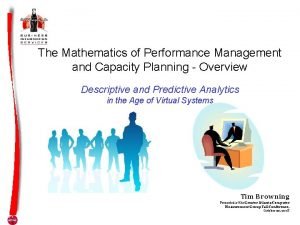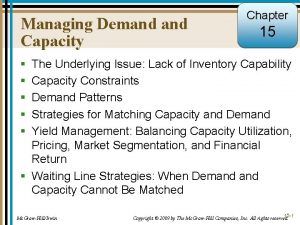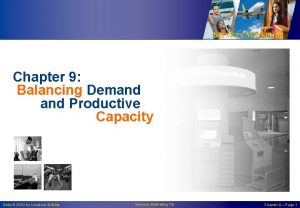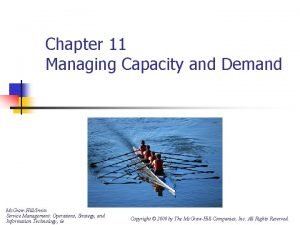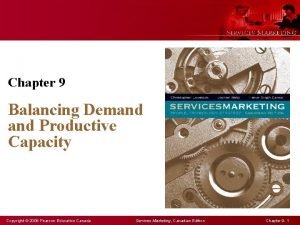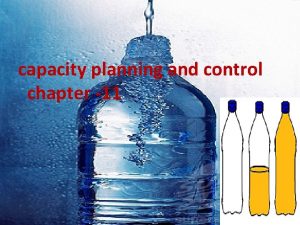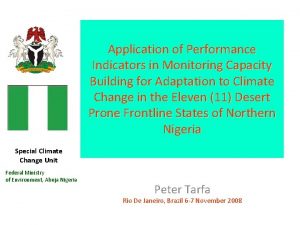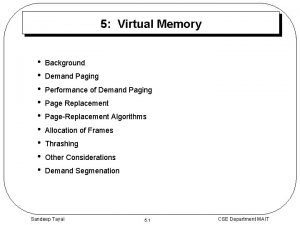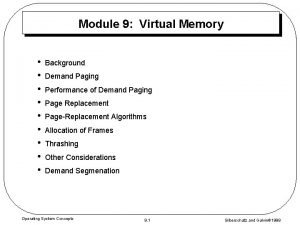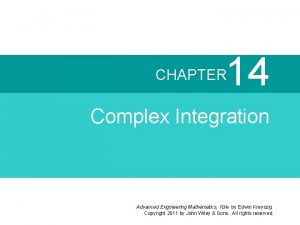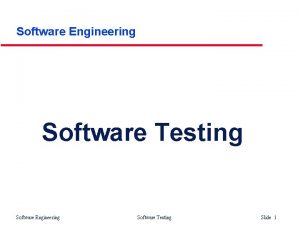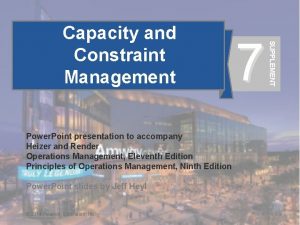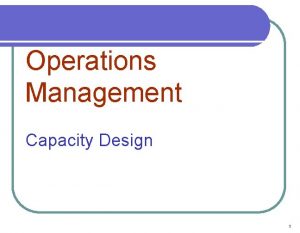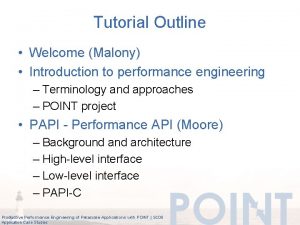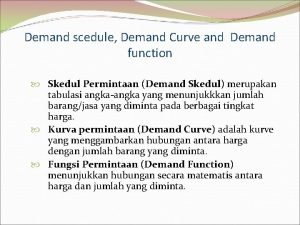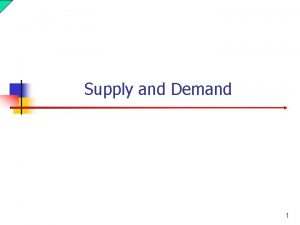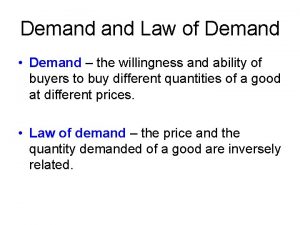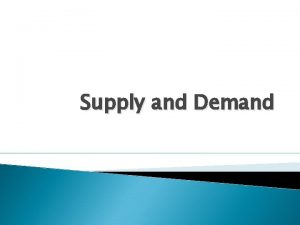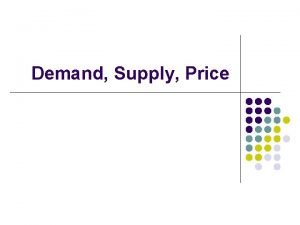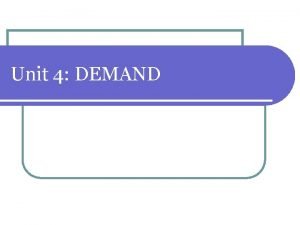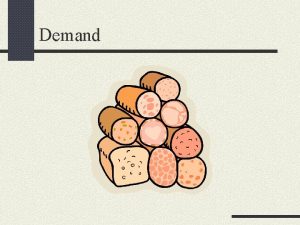Capacity Management Demand Management and Performance Engineering Integration









































- Slides: 41

Capacity Management, Demand Management, and Performance Engineering Integration Ann Dowling adowling@us. ibm. com © 2009 IBM Corporation

IT Optimization and Service Management The Capacity Management Process is comprised of six key Activities. Establish Capacity Management Framework: Based on the business and IT strategy and the architectural models, guidelines and a framework for capacity management will be developed. M a n a g i n g t h e P r o c e s s § Model and Size Capacity Requirements: E x e c u t i n g t h e P r o c e s s – Modeling involves performance and capacity prediction through estimation, trend analysis, analytical modeling, simulation modeling and benchmarking. Application sizing is a technique that predicts the capacity solution required to meet service level requirements for response times, throughput, and batch elapsed times. § Monitor, Analyze, and Report Capacity Usage: – Monitors should be established on all the components and for each of the services. The data should be analyzed using, wherever possible, expert systems to compare usage levels against thresholds. The results of the analysis should be included in reports, and recommendations made as appropriate. §Supervise Tuning and Capacity Delivery: – Outputs from monitoring, analyzing, and reporting activities are examined and actions to tune individual resources or to re-balance the available capacity are planned and initiated through Change and Release Management. § Produce and Maintain Capacity Plan: – The objective of this activity is to develop, maintain, test and revise alternative approaches in satisfying various enterprise-shared resource requirements. It delivers the capacity plan that addresses the customer's resource requirements. Evaluate Capacity Management Process Performance: Measurements include the definition, collection of measurements, analysis, review and reporting for Capacity Management. 2

IT Optimization and Service Management There are three sub-processes that comprise the ITIL® Capacity Management process. Each uses the primary activities of the process decomposition in differing ways, to differing stakeholders, to differing end results. Business Capacity Management (BCM) § translates business needs and plans into requirements for service and IT infrastructure, ensuring that the future business requirements for IT services are quantified, designed, planned and implemented in a timely fashion Service Capacity Management (SCM) § management, control and prediction of the end-to-end performance and capacity of the live, operational IT services usage and workloads Component Capacity Management (CCM) § management, control and prediction of the performance, utilization and capacity of individual IT technology components "ITIL ® is a Registered Trade Mark, and a Registered Community Trade Mark of the Office of Government Commerce, and is Registered in the U. S. Patent and Trademark Office" 3

IT Optimization and Service Management Elements of Demand Management are the main source of business demand that Capacity Management uses to develop capacity forecasts and solutions. Conceptual View Business processes are the primary source of demand for services. Patterns of business activity (PBA) influence the demand patterns seen by the service providers (Figure 5. 23) Excerpted from “Service economics” chapter of it. SMF publication for ITIL® V 3 core documents, 2008 -12 -15. 4 It is very important to study the customer’s business to identify, analyse and codify such patterns to provide sufficient basis for Capacity Management. Visualize the customer’s business activity and plans in Note: IBM provides additional process guidance supporting Demand Management and other ITIL processes. • IBM Tivoli Unified Process (ITUP) terms of the demand for supporting services

IT Optimization and Service Management And…add ITIL V 3 Service Strategy Demand Management for ‘sense and respond’ alignment with client Business Transformation ITIL® Demand Management Key Activities: § Establish Demand Management framework § Value and classify business demands § Consolidate business demand patterns and forecasts § Forecast service demand § Identify and plan demand management initiatives § Assess and report demand management outcomes § Evaluate demand management performance Capacity Management translates demand through to the component level. 5

IT Optimization and Service Management Several tasks in the Demand Management process need to be driven by the Capacity Management team in order to initiate progress toward improved capacity requirements and forecasts. Demand Mgmt. Key Activity Demand Mgmt. Task Relationship with Capacity Management Note: This is a minimal subset to provide input to Capacity Management for Demand Management 6 Value and Classify Business Demands Identify and Analyze Business Demand Streams and Demand Work with business areas to gather business demand information, analyze types of demand in business terms and obtain trend of the demand - For customers of IT, internal and external Forecast Service Demand Create Business Demand Forecasts Work with business areas to create forecasts of business demand for major business areas Assess & Report Demand Mgt. Identify Service Demand Baselines Determine existing baselines for service demand. for given business areas Forecast Service Demand Translate Service Demand to Service Consumption Units Convert service demand into service consumption units for the business areas Forecast Service Demand Translate Business Demands to Service Demands Take business demand data and results and identify demand for specific IT services Forecast Service Demand Create Service Demand Forecasts Take the Service Demands and create forecast for the required IT services (input to “Model and Size Capacity Requirements” and “Produce and Maintain Capacity Plan”

IT Optimization and Service Management IBM leverages its Performance Engineering and Management Method (PEMM) for its engagements. § PEMM was first outlined in 1998 in an IBM internal white paper, as a comprehensive approach to addressing performance throughout the lifecycle of a custom application development (CAD) project. § It was developed into a comprehensive method with full elaboration of the eight major Themes, supporting Work Products, exploration of the Role of the Performance Architect and the mult-disciplinary Performance Engineering Team § In addition to the traditional disciplines of performance testing and performance/capacity planning and management, PEMM stresses the need for proactive performance engineering tasks which should be taking place during earlier project phases (i. e. requirements, architecture, design & development) and managing the scalability, capacity and performance in the production environment. § PEMM is the basis of an internal IBM course on “Architecting for Performance” that is included in the education roadmap for the IBM Architect Profession. § PEMM has been customized by IBM on multiple engagements across several industries, including several large Insurance industry clients. 7 PHASES THEMES PEOPLE The three dimensions of Performance Engineering: • The project Phases and deliverables dimension defined in your project development standards • The People dimension in which you build and maintain your relationships with other key members of the project and within the Performance Engineering team itself. • Themes dimension in which you maintain and drive forward the longer conceptual threads of activity needed to help you achieve your objectives.

IT Optimization and Service Management The PEMM themes apply across the life cycle and produce a set of outputs also shared and refined throughout the life cycle. PEMM directly maps to YOUR life cycle and beyond into Introduction and Deployment. Software Development Life Cycle Startup Solution Outline Macro Design Solution Requirements Micro Design Build Deployment Solution Close ►Performance Engineering and Management Method performance engineering activities completed in the earliest part of the project to ensure performance and capacity requirements are well-defined and assessed at the outset Requirements and Early Design analyzing the quantitative (volumes) factors, both business and technical, that will effect system performance Volumetrics activities associated with predicting future performance behavior or capacity requirements of a system Performance Estimation and Modeling investigation required to make estimation and modeling more accurate and fact-based PE activities conducted during the development life cycle Design, Development, and Tracking include supporting design and code reviews and establishing performance time or resource utilization budgets test and assess the performance of the live solution, Performance Testing and Validation usually by an independent performance test team Technology Research manage performance and capacity of the deployed solution in production, using monitoring tools and processes and service level agreements Live Monitoring and Capacity Management Risk and Performance Management Outputs ensure risks related to performance and capacity are properly identified, assessed and addressed 8 § PE Strategy § Non-Functional Requirements § Business Volumetrics § PE Risk Assessment and Containment Plan § PE Plan § Performance Critical Use Cases § Technical Volumetrics § Performance Budgets § Performance Model § § Application Profiles Capacity Sizing Monitoring Plan Performance Test Cases § Measurement Specifications § Performance Analysis Results § Tuning Recommendations § § § Performance Service Levels Monitoring Thresholds/Alerts Implemented Tuning Capacity Plan vs. Actual reports

IT Optimization and Service Management Integration points foster mutual awareness and collaboration between the Capacity Management process and Performance Engineering themes which mutually strengthens the overall effectiveness. Capacity Planning for a future system deployment Capacity Management for a deployed system Capacity Management view as embodied in ITIL and IBM’s ITUP Business Supervise Tuning and Capacity Delivery Model and size capacity requirements Monitor, Analyze and Report Capacity Usage (Service Management perspective) Performance Engineering view as embodied in PEMM (Solution Design and Delivery perspective) Volumetric s Requirements and Early Design Estimatio n and Modeling Service Design, Developmen t and Tracking Technolog y Research Test Planning and Execution Produce and maintain capacity plan Live Production Component Performance Engineering of a solution being developed and/or assembled Performance Management of a solution being deployed 9

IT Optimization and Service Management The convergence of Capacity Management, Demand Management, and Performance Engineering (PEMM) provides a powerful and truly full life cycle methodology. Demand Management Patterns of Business Activity and Demand Policies Performance Engineering Risk Assessment Non-Functional Requirements Performance Model Capacity Management Information System & Capacity Plan Performance Engineering & Management Method (PEMM based) Capacity Management Process (ITIL® based) Feasibility 10 Design Development Test • IBM’s Performance Engineering & Management Method (PEMM) • IT Infrastructure Library (ITIL®) Deploy Production Optimize

IT Optimization and Service Management ØModel and Size Capacity Requirements Supervise Tuning and Capacity Delivery Model and size capacity requirements Monitor, Analyze and Report Capacity Usage Produce and maintain capacity plan Volumetrics Requirements and Early Design Estimation and Modeling Technology Research 11 Design, Development and Tracking Live Production Test Planning and Execution

IT Optimization and Service Management ØModel and Size Capacity Requirements § Modeling involves performance and capacity prediction through estimation, trend analysis, analytical modeling, simulation modeling and benchmarking. Modeling can be performed for all or any layer of the IT solution including the business, application and technology infrastructure. § Application sizing is a technique that predicts the service level requirements for response times, throughput, and batch elapsed times. It also: • predicts resource consumption and cost implications for new or changed applications • predicts the effect on other interfacing applications. 12

IT Optimization and Service Management Modeling involves one or more techniques must be selected when modeling workload behavior and associated resource requirements. § Modeling Objectives: – Predict the behavior of IT Services under a given volume and variety of work using: • • Pilot studies Prototypes Full scale benchmarks Trend analysis Analytical modeling Simulation modeling Baseline models § Like modeling and forecasting during a solution development project: – No single technique can apply to all situations – One or more techniques must be selected when modeling workload behavior and associated resource requirements 13

IT Optimization and Service Management Application Sizing has a strong correlation with Performance Engineering. § Application Sizing Objectives – Estimate resource requirements for new or changed application – To ensure it meets required service levels – Has to be an integral part of the applications lifecycle § Application sizing has a finite life-span – Initiated at Project Initiation stage for a new application – Major Change to an existing Application – It is performed at the beginning of the solution lifecycle and continues through the development, testing and implementation phases. § Service Levels defined – During initial systems analysis and design – Enables use of pertinent technologies & products – Easier and less expensive to consider early in application lifecycle § Modelling can be used within Application Sizing § Applies to Application Packages (COTS): – Research similar customers & do benchmarks 14

IT Optimization and Service Management The Testing / Modeling Continuum is a guide to determining which forecasting technique should be used in a particular situation. Cost & Time Benchmark Linear Extrapolation Full Production Testing + Simulation Model Testing + Analytic Model Scalability Testing Simulation Model Analytic Model Forecast Accuracy 15 +/- 10~15% +/- 5~10%

IT Optimization and Service Management Capacity modeling can be utilized to project the infrastructure requirements for any production or test based application. Basic Capacity Planning (Scalability) Methodology § Identify key workloads / transactions and develop a performance metric collection strategy § Collect performance and configuration data required to construct the models § Create and calibrate the model to base system metrics § Utilize the calibrated baseline model to project future business scenarios § Analyze modeling results and identify application and infrastructure requirements § Create and deliver final report and softcopy performance models 16

IT Optimization and Service Management ØMonitor, Analyze, and Report Capacity Usage Supervise Tuning and Capacity Delivery Model and size capacity requirements Monitor, Analyze and Report Capacity Usage Produce and maintain capacity plan Volumetrics Requirements and Early Design Estimation and Modeling Technology Research 17 Design, Development and Tracking Live Production Test Planning and Execution

IT Optimization and Service Management ØMonitor, Analyze, and Report Capacity Usage § Monitors should be established on all the components and for each of the services. § The data should be analyzed using, wherever possible, expert systems to compare usage levels against thresholds. § The results of the analysis should be included in reports, and recommendations made as appropriate. § There is a fundamental level of data collection and reporting necessary in any environment before capacity and performance services can be established. § Monitors and Data Collection and Reporting suites might be required at many levels, including but not limited to, the operating system, the database, the transaction processor, middleware, network, Web Services, and end-to-end (user) experience. 18

IT Optimization and Service Management Objectives of Monitoring and Analysis Monitoring objectives: §Measure the utilization of each resource and service on an on-going basis to ensure: – the optimum use of the hardware and software resources – that all agreed service levels can be achieved – that business volumes are as expected Analysis objectives: §Identify trends from which the normal utilization and service level, or baseline, can be establishes §Identify exception conditions in the utilization of individual components or service thresholds by regular monitoring and comparison with the baseline thresholds §Identify and report breaches or near misses in the SLAs §Predict future resource usage, or monitor predicted growth against actual business growth (plan vs. actual) 19

IT Optimization and Service Management Several categories of monitoring are within the scope of the Capacity Management process. Utilization Monitoring Response Monitoring § Processor utilization § Incorporating specific code within client and server § Memory utilization applications software (application instrumentation) § Per cent processor per transaction type§ Using ‘robotic scripted systems’ with terminal emulation software § IO rates (physical and buffer) and device utilization § Using distributed agent monitoring soft § Queue lengths § Using specific passive monitoring systems § Disk utilization § Transaction rates Durations for Monitoring § Response times § Real-time (events) § Batch duration § Historical § Database usage – Problem determination and root cause analysis § Index usage – Trend analysis § Hit rates – Planning § Concurrent user numbers § Network traffic rates. 20

IT Optimization and Service Management Composite application monitoring and management offers end-to-end visibility within applications and infrastructure components. Secure Zone DMZ Voice Services Insesure Zone VPN Rel. DB Process Server Application Servers Agent Gateway Internet Portal Service Registry Agent Partner Services Agent Existing Applications Web Servers Customers Enterprise Service Bus Connectors Adapters Agent Web Servers Integrated Service Composite Application Management Monitoring & Management 21 Intranet Émployees Infrastructure Services Security Services

IT Optimization and Service Management The ITIL Capacity Management sub-processes are carried out across several key activities. Source: ITIL Service Design © Crown Copyright 2007 According to ITIL, a CDB or CMIS is a cornerstone of a successful Capacity Management process. 22

IT Optimization and Service Management Data Collection begins with establishing a methodology for ensuring that data and measurement requirements are well understood and can be achieved. Data collected must account for resource usage, accommodate forecasts, and provide for monitoring and tuning the system. –Which tool(s) to use for data collection and reporting • Metric data – data repository • Non-metric data – document repository –Frequency of collection and summarization • Detail, hourly, daily, weekly, monthly, quarterly • Peak vs. average –View of data / information • Business, Application, or Project view • Service view • IT Component view • Location view –Levels of detail • Shared vs. dedicated resources • Workload level (i. e. , process id) vs. transaction level 23 The CMIS (Capacity Management Information System) repository will be the primary source of the system data needed forecasting. Carefully designed categorization of data allows for flexibility in reporting and analysis from various views.

IT Optimization and Service Management A diverse set of data and information can be compiled into a set of application profiles valuable as both inputs and outputs throughout the Capacity Management process. § Business data – Business transactions – Schedule of business events – Business drivers § Service data – Response Time service objectives / levels – Elapsed time, End time, Turnaround Time, Throughput – Maintenance windows § Technical data – CPU type, model, serial – available capacity (MIPS), memory (Central and Expanded), channels, number of cps, speed of cps, weight – Operating System, Subsystems § Financial data – Financial plans – IT budgets, including specific budgets for hw and sw expenditure – external suppliers, for cost of new hw and sw upgrades § Utilization data – IT resource measurements by workload groupings • CPU resource usage (utilization) • Storage usage (utilization) 24 A composite of all this information can be organized into a set of application or workload profiles. Nonmetric and metric data Application xyz Application abc Workload 123 Application or Workload Profiles provide the workload characterization: § Application behavior over time § patterns, peaks § Aggregation or groupings § Growth requirements, growth scenarios Various analysis and reporting are also derived from use of the CDB or CMIS.

IT Optimization and Service Management A common, standard set of resource usage data can be shared by performance, capacity, and usage-based show-back to forecast and manage IT demand. Consistent, standardized data collection is crucial to ensure that the metrics needed for performance monitoring, capacity planning (forecasting), and chargeback are readily available. Raw Data from Agents Event Monitoring and Management • Alerts, Alarms • Thresholds Short Term: performance bottleneck analysis (IT resource, application, process, or thread level) • Problem determination • Root cause analysis Long Term: Capacity Planning • Trending, plan vs. actual analysis • Forecasting • Sizing • Modeling, statistical regression IT Accounting: usage-based chargeback • Pricing • Billing • Forecasting • Variance analysis Time Range 25 Metrics collected from various platforms, databases, sub-components and applications address the entire range of scope – from immediate alerts and problem determination to long term capacity planning and usage-based billing. It is very important to determine which metrics to collect on an ongoing basis, with varying levels of detail applicable to specific situations. It is crucial to map resource usage metrics to the corresponding applications and business units consuming the resource.

IT Optimization and Service Management ØSupervise Tuning and Capacity Delivery Model and size capacity requirements Monitor, Analyze and Report Capacity Usage Produce and maintain capacity plan Volumetrics Requirements and Early Design Estimation and Modeling Technology Research 26 Design, Development and Tracking Live Production Test Planning and Execution

IT Optimization and Service Management ØSupervise Tuning and Capacity Delivery § Outputs from monitoring, analyzing, and reporting activities are examined and actions to tune individual resources or to re-balance the available capacity are planned and initiated through Change and Release Management or through the Service Desk in the case of simple requests to other support groups or self-help for users. § Some recommendations might involve changes in the way that the users use the IT systems: – moving discretionary workloads to off-peak periods – performing a business function using a more efficient IT service path – balancing services – changing concurrency levels – adding or removing resources § The cycle then begins again, monitoring any changes made to ensure they have had a beneficial effect and collecting the data for the next day, week, or month. 27

IT Optimization and Service Management Supervise Tuning and Capacity Delivery § Service and component tuning: – enables effective utilization of IT resources by identifying inefficient performance, excess or insufficient capacity, and making recommendations for optimization. It can – balances the need to maintain service while reducing capacity capability to reduce the cost of service. § Understanding the combined performance impact of various components within a complex infrastructure is needed to accurately differentiate symptoms from actual problems. This level of understanding provides the most accurate baseline for future planning. 28

IT Optimization and Service Management Various techniques can be used for tuning. Tuning objectives: § Identify areas of the configuration that could be tuned to better utilize the system resource or improve the performance of the particular service Implementation objectives: § Introduce to the live operation services any changes that have been identified by the monitoring, analysis and tuning activities Tuning techniques that are of assistance include: § Balancing workloads and traffic – transactions may arrive at the host or server at a particular gateway, depending on where the transaction was initiated; balancing the ratio of initiation points to gateways can provide tuning benefits § Balancing disk traffic – storing data on disk efficiently and strategically, e. g. striping data across many spindles may reduce data contention § Database locking strategy - definition of an accepted locking strategy that specifies when locks are necessary and the appropriate level, e. g. database, page, file, record and row – delaying the lock until an update is necessary may provide benefits § Efficient use of memory – may include looking to utilize more or less memory, depending on the circumstances 29

IT Optimization and Service Management ØProduce and Maintain Capacity Plan Supervise Tuning and Capacity Delivery Model and size capacity requirements Monitor, Analyze and Report Capacity Usage Produce and maintain capacity plan Volumetrics Requirements and Early Design Estimation and Modeling Technology Research 30 Design, Development and Tracking Live Production Test Planning and Execution

IT Optimization and Service Management ØProduce and Maintain Capacity Plan The objective of this activity is to develop, maintain, test/model and revise alternative approaches in satisfying various enterprise-shared resource requirements. • Inputs: –forecast assumptions –forecast projections –subject matter expert recommendations • Controls: –financial constraints –hardware constraints –performance policies –resource standards and definitions –strategy and direction. • Deliverables: –agreed capacity plan –alternative solutions –optimized resource solution 31

IT Optimization and Service Management Forecasted resource requirements (demand) can provide quantified IT resource ‘volumetric’ input (load) to testing or modeling studies that analyze the impact of the projected IT resource load and exercise various solution alternatives to satisfy the demand. Establish Baseline: Define Content and Scope Select representative time Period Determine Metrics to characterize Determine time Durations Develop forecast requirements (demand): Define objectives of forecast Determine forecasting horizon Select appropriate set of forecasting techniques Define growth scenarios • Conservative, Most-likely, Aggressive Quantify forecasted requirements (demand) into IT resource requirements (load) over time Conduct Testing / Modeling Studies: Calibrate the baseline Apply forecasted requirements (demand) against baseline Analyze impact of forecasted IT resource volumetrics (load) over time Exercise various solution alternatives Document assumptions and risks Recommend conservation actions Capacity Plan: Consolidate growth plans for all workloads • existing workloads • new applications, enhancements to applications • changes to the IT environment / infrastructure Recommend solutions Document associated approaches, assumptions, risks Track through plan vs. actual analysis 32

IT Optimization and Service Management IT resource usage Capacity planning is needed to help evaluate existing and new applications, as well as changes in your business environment. Each of the three major sources of growth must consider the impact of business growth expectations and planned business events. ENVIRONMENTAL CHANGES NEW APPLICATIONS GROWTH IN EXISTING APPLICATIONS BASELINE USAGE t 0 Time t 1 Capacity planning mission The goal of the capacity planning process is to help ensure that sufficient costeffective capacity is available to meet existing service level commitments, as well as business and application growth requirements. 33

IT Optimization and Service Management Composite views of IT resource estimates are developed based on the aggregation of the individual resource requirements. § All of the requirements are summarized, or subtotaled, to develop an aggregate or composite view of the overall, enterprise-wide resource requirements or demand § IT resource composite views can include: – – – Servers Storage Data Network Voice Network Middleware Database § A composite view of IT resource requirements can be analyzed at various levels of breakout and detail: – – 34 Locations Key applications/workloads Business functions Physical processors

IT Optimization and Service Management Individual requirements are developed at a more detailed level that is typically based on a reasonable set of key applications/workloads. Workload grouping assists in determining what level of detail provides an effective aggregation for a composite view that is reasonable and appropriate for the Capacity Plan. Workload grouping: § Defining key applications/workloads – Top resource load § Group or Aggregate like application/workloads – Similar resource usage characteristics • By IT resource component: an application / workload could surface as ‘key’ in some component areas and not in others – Similar growth characteristics: one or more of these factors can justify aggregation: • • • 35 Similar seasonal trends Similar growth rates (monthly, annually) Similar historical trends Similar business drivers (estimation or correlation) Similar impact from business events

IT Optimization and Service Management Validation of forecasts must be done on a regular basis. One common approach is plan vs. actual analysis. If the actuals deviate significantly or consistently from the plan then investigation into the cause and possible adjustment to the forecast is necessary. 36

IT Optimization and Service Management Once the source of the deviation from plan has been determined then the cause of the deviation must be investigated. § What forecasting technique was used ? – If business-driven, has the business driver forecast changed ? – If historical trend, has some change been introduced that was not known ? – Is there an unplanned business event or project that has occurred and is potential impacting the workload ? § Is it possible to drill down further within the workload to further isolate the source of the deviation ? – perhaps at the application level § Are there any related problems that have been reported, such as response time degradation, etc. ? § What is the degree of risk/impact from this deviation ? – Is a forecast adjustment necessary ? § How do I adjust the forecast ? – One time event only ? – Seasonal adjustment ? – Long term adjustment ? § Why do I adjust the forecast ? – What assumptions need to be modified ? – Is a different forecasting technique more appropriate ? § What measurements do I have to quantify the necessary adjustments ? § What measurements were used to quantify the baseline and the forecasts ? § Was the baseline valid or does it have some inherent problems or exceptions that need to be resolved ? § What were the assumptions ? Without sufficient levels of data grouping, it can be very difficult to drill down to the probable source of the deviation and therefore difficult to determine the cause of the deviation of actual to plan. 37

IT Optimization and Service Management The convergence of Capacity Management, Demand Management, and Performance Engineering (PEMM) provides a powerful and truly full life cycle methodology. Demand Management Patterns of Business Activity and Demand Policies Performance Engineering Risk Assessment Non-Functional Requirements Performance Model Capacity Management Information System & Capacity Plan Performance Engineering & Management Method (PEMM based) Capacity Management Process (ITIL® based) Feasibility 38 Design Development Test • IBM’s Performance Engineering & Management Method (PEMM) • IT Infrastructure Library (ITIL®) Deploy Production Optimize

IT Optimization and Service Management Integrating work products into the existing phases or gates of the SDLC, project management, and other key business and service management processes helps to operationalize or institutionalize PE. Phases & Work Products (Data and Tools) PHASES THEMES & ACTIVITIES PEOPLE What the team needs to do or to produce in each phase of the project. Organization People in the project that you need to work with to achieve your objectives Method / Process (Themes / Activities) Long term elements of system design, development, and delivery that interact with Performance Engineering 39

IT Optimization and Service Management The role of the Performance Engineer or Performance Architect requires multi-faceted skills and responsibilities. § A person who carries out performance engineering duties and leads a Performance Engineering project or team is referred to as a Performance Engineer or Performance Architect. § Performance Engineering is most successful when it is carried out by a multi-disciplinary team representing the major business and technical stakeholders in a project or solution: – Requirements Analysts – Architects – Developers – Infrastructure and Application Engineers – Testers – Capacity Planners – Performance Analysts 40

IT Optimization and Service Management 41
 Demand management and capacity management
Demand management and capacity management Capacity planning predictive analytics
Capacity planning predictive analytics Production units have an optimal rate of output where
Production units have an optimal rate of output where Module 5 supply and demand introduction and demand
Module 5 supply and demand introduction and demand Managing demand and capacity
Managing demand and capacity Balancing demand and capacity
Balancing demand and capacity Balancing demand and capacity
Balancing demand and capacity Alternative times
Alternative times Managing capacity and demand chapter 11
Managing capacity and demand chapter 11 Balancing demand and productive capacity
Balancing demand and productive capacity Three dimensions of corporate strategy
Three dimensions of corporate strategy Vertical diversification example
Vertical diversification example Example of simultaneous integration
Example of simultaneous integration Measures to correct excess demand and deficient demand
Measures to correct excess demand and deficient demand Example of independent demand
Example of independent demand Example ng demand schedule
Example ng demand schedule Demand estimation in managerial economics
Demand estimation in managerial economics Paradox of value
Paradox of value Inventory planning for independent demand items
Inventory planning for independent demand items Alternative capacity plans
Alternative capacity plans Behaviorally anchored rating scale
Behaviorally anchored rating scale Performance levels
Performance levels Deterministic demand vs stochastic demand
Deterministic demand vs stochastic demand Individual demand vs market demand
Individual demand vs market demand Dependent demand example
Dependent demand example Assumptions of moho
Assumptions of moho Key performance indicators for capacity building
Key performance indicators for capacity building Performance of demand paging
Performance of demand paging Performance of demand paging
Performance of demand paging Higher engineering mathematics
Higher engineering mathematics Software engineering
Software engineering Focusing on broad organizational needs
Focusing on broad organizational needs Forward engineering in software engineering
Forward engineering in software engineering Jcids manual 2018
Jcids manual 2018 Capacity and constraint management
Capacity and constraint management Leading demand with incremental expansion
Leading demand with incremental expansion Types of capacity in operations management
Types of capacity in operations management Capacity allocation and congestion management
Capacity allocation and congestion management Performance engineering tutorial
Performance engineering tutorial Technical performance measures
Technical performance measures Abet performance indicators
Abet performance indicators Engineering performance metrics
Engineering performance metrics

